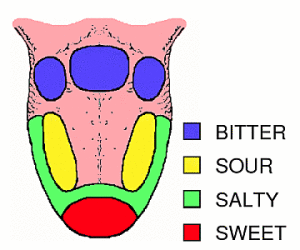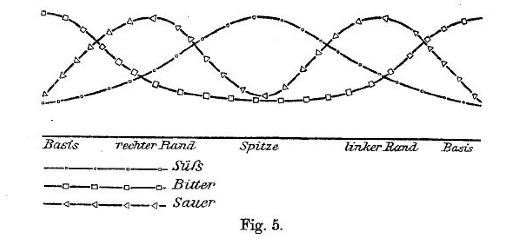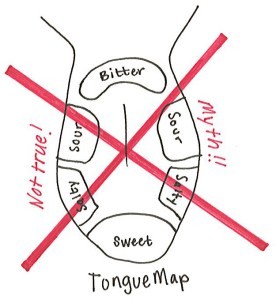Ok, so now that we know that the tongue map is only a myth, let’s get to a topic that is thoroughly backed up with science- the basic tastes.
So what is a basic taste? Technically it’s a taste that one is able to distinguish through repeated tests and trials as a separate, singular taste. (So you’re clearly tasting one thing and not a combination of other tastes).
If you ask your local food/sensory scientist, they’ll be able to rattle off the five basic tastes without even thinking: sweet, salty, bitter, sour, and umami (savory). Research has shown that there may be another, but we’ll get to that later.
While the tongue maps is a bust, here’s what we do know about how these basic taste are detected all throughout the tongue. Tastants can either: flow directly through an ion channel, bind and block ion channels, or bind to a G-protein coupled receptor (GPCR).While that last sentence wasn’t the clearest the in world, hopefully this graphic will clear it up.

In cognitive psychology, we’ve already seen an action potential before, that’s how nerve signals are transmitted throughout the body. It’s also the same way we taste sour and salty! You can remember because salts can be many ions including Na+ and Cl-, and sour tastes are acidic, so think of H+ ions. As seen on the Figure, the ions for salty and sour pass through an ion channel which causes that influx of sodium, leading to depolarization which then triggers potassium ions to move out. It is then at this point where calcium plays a role.
The tastes of sweet, bitter, and umami however go through different receptors. There are specific types of receptor depending on the taste (for example bitter is T2Rs). These receptors are held in place with the G-proteins, and after they pass through the process of depolarization starts, so the only difference is how the tastant first pass through the taste pore.
It’s important to note that serotonin, a neuromodulator we discussed, serves as a sort of intermediate transmitter to help communication between the taste pore and the rest of the taste bud.
So what about umami? It’s a word derived from the Japanese language, which translates into “pleasant savory taste”: umai means “delicious” and mi “taste.” (We’ll just agree that calling things “delicious” is not good scientific term”.
While savory is closest singular word to describe it, think of umami as the taste of chicken broth or a shitake mushroom. Monosodium glutamate (MSG), is also used as a descriptor for it. In addition to being in a variety of broths, the taste is also present in many Asian cuisines.
Remember how the defining characteristic of a basic taste is that it has to be distinguishable from all others? A characteristic like umami has been known in the scientific community as early at the 1910’s. However, proving that it was indeed a basic taste took some time.
Shizuko Yamaguchi helped develop this graph which shows how the taste of umami “stands on its own” and isn’t dimensionally close to the other tastes.

Further scientific evidence also showed that umami had its own taste receptors, further cementing its place a basic taste.

While umami has been established, science is leading towards the discovery of another basic taste, it’s called oleogustus, the taste of fat (oleo is a Latin root meaning ‘oily’).
Out of Purdue University a study was done to see of participants could come up with words to describe the taste of fat. It was very important to the researchers that the participants didn’t confuse the texture of fat (creamy, smooth) with the taste.

Participants were told to sort a variety of sample into different groups dependent on taste (often called a sorting task). While initially they placed the fat samples with the bitter samples, upon further testing between the fat and bitter they made a separate fatty acid group. While more research needs to be done (will they find a ‘fat’ receptor?), it’s an important step in the right direction.
Fun fact: Cordelia Running, who helped pioneer this study at Purdue, is now a post-doc in Food Science Department here at Penn State!






